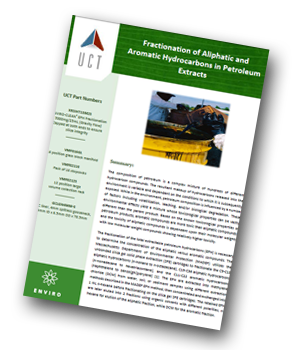UCT has produced an application note describing the fractionation of aliphatic and aromatic hydrocarbons in petroleum extracts using UCT’s EPH silica gel SPE cartridges. The fractionation of the total extractable petroleum hydrocarbons (EPH) is necessary to determine the concentration of the aliphatic versus aromatic compounds.
 Introduction
Introduction
The composition of petroleum is a complex mixture of hundreds of different hydrocarbon compounds. The resultant makeup of hydrocarbons released into the environment is variable and dependent on the conditions to which it is subsequently exposed. While in the environment, petroleum composition is influenced by a number of factors including volatilization, leaching, and/or biological degradation. These environmental effects yield a mixture whose toxicological properties can be vastly different than the parent product.
Method
The Massachusetts Department of Environmental Protection (MADEP) utilizes the unbonded silica gel solid phase extraction (SPE) cartridges to fractionate the C9-C18 aliphatic hydrocarbons (n-nonane to n-octadecane), C19-C36 aliphatic hydrocarbons (n-nonadecane to hexatriacontane), and the C11-C22 aromatic hydrocarbons (naphthalene to benzo(ghi)perylene). The EPH are extracted into methylene chloride (DCM) from water, soil, or sediment samples using different extraction methods described in the MADEP EPH method, then concentrated and exchanged into 1 mL n-hexane before fractionating on the silica gel SPE cartridges. The retained EPH are later eluted into 2 fractions using organic solvents with different polarities, n-hexane for elution of the aliphatic fraction, while DCM for the aromatic fraction.
Conclusion
The silica gel product is shown to provide a reliable method for the cleanup and fractionation of EPH in environmental samples. Excellent analytical performance has been obtained using UCT’s EPH silica gel SPE cartridges (heat treated, large particle size) for the fractionation of aliphatic and aromatic hydrocarbons. Recoveries were ranged from 90.7 to 94.6% for 3 EPH fractions, aliphatic C9 – C18, C19 to 36, and aromatic C11 – C22, with relative standard deviations (RSD%) < 3%, which well passed the QC requirements set by the MADEP EPH method: 40 - 140% in recovery and RSD% < 25%.
